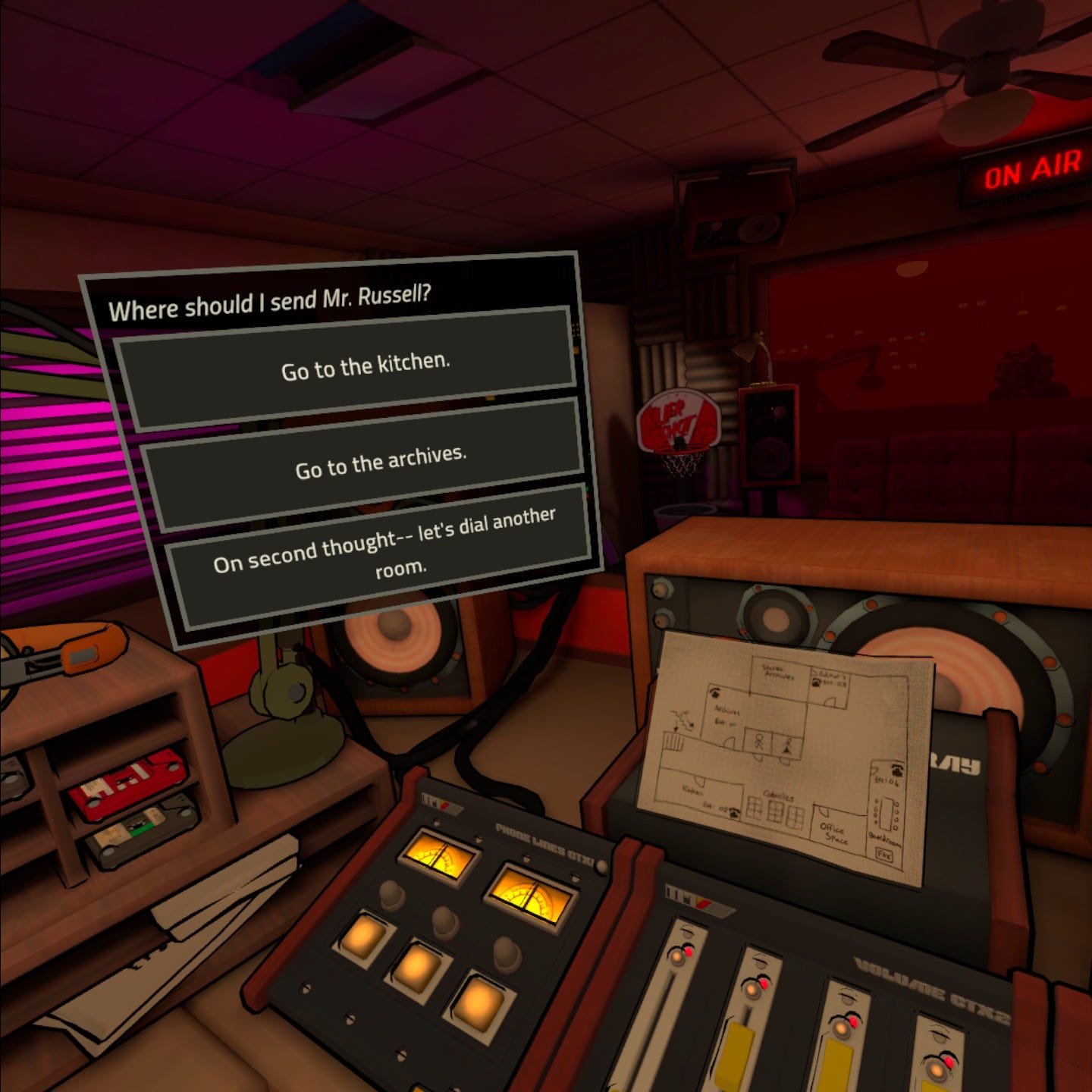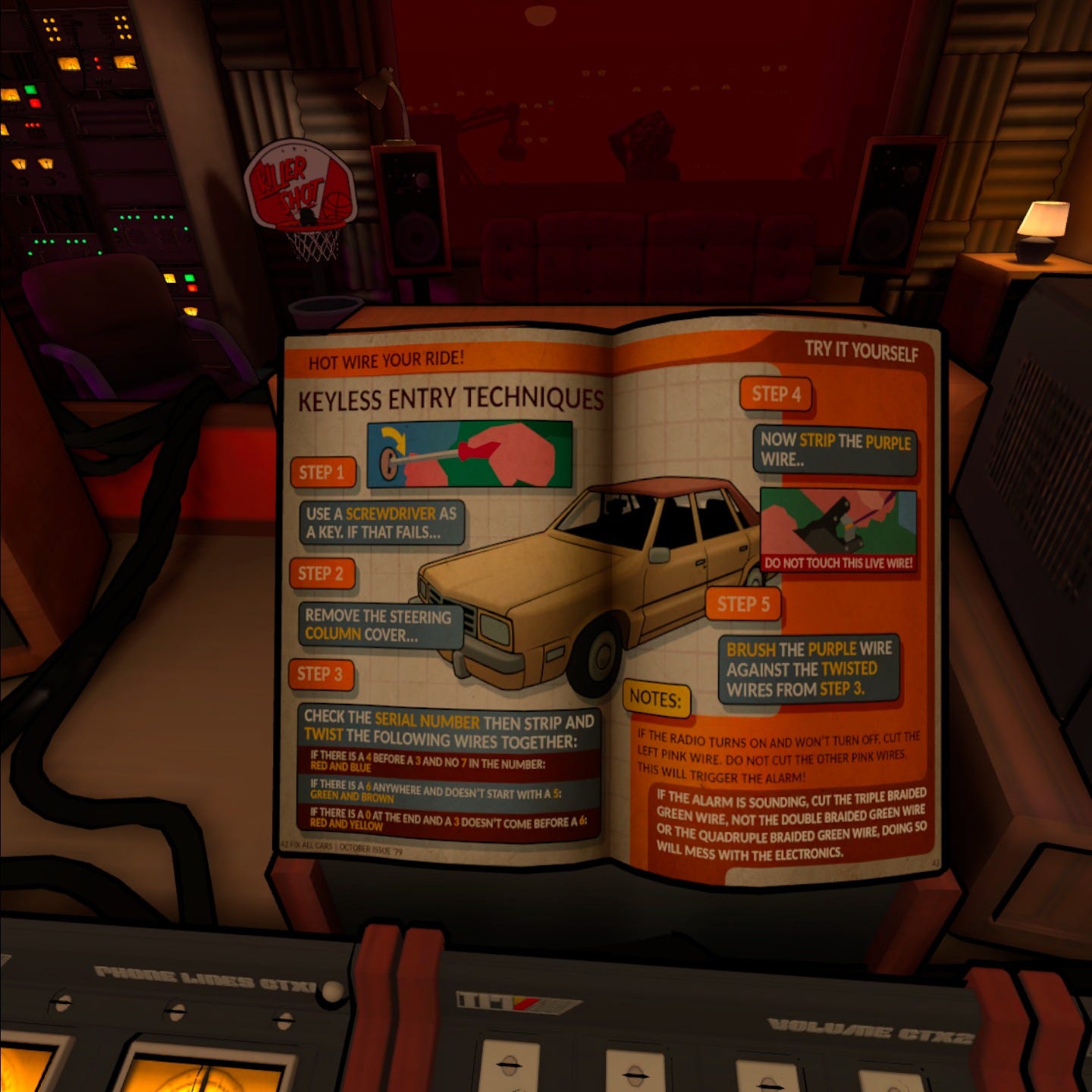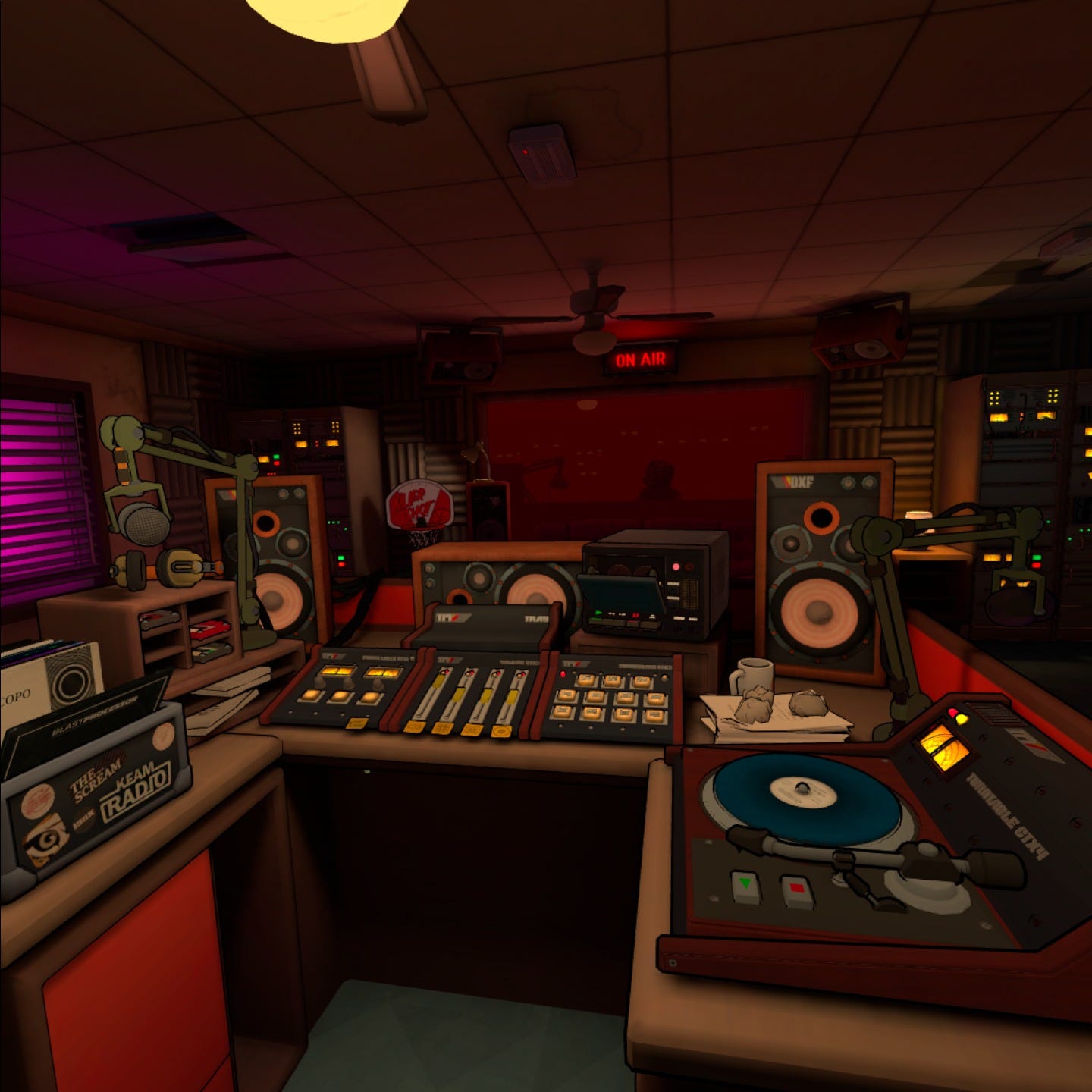Killer Frequency
More filler than killer
PC, PlayStation, Xbox, Switch, Meta Quest 2
$24.99
5 hours long
Killer Frequency is a first-person horror adventure game where you play a late night DJ who helps people escape a serial killer by solving puzzles for them (e.g. navigating a hedge maze, hotwiring a car). You find clues to puzzles by exploring the radio station’s offices, which itself requires solving more puzzles like repairing a fuse box.

Most of the time you’re sitting in your DJ booth chatting with callers and your producer. During conversations, you can choose between a few approaches (“friendly”, “neutral”, or “asshole”, as usual), and you’ll use the same mechanism to direct callers during puzzles. Very rarely, there’s a time limit for you to make a choice, but even then I didn’t feel especially rushed. Outside of that, you’ll periodically move things along by playing a record, inserting a cassette, and switching between phone lines. It’s all pleasingly tactile, with bright, detailed graphics.
The game is centred around the set pieces where you try to save people from the serial killer. These usually start with someone calling in to the radio station in terror; the killer is approaching but they dropped their keys so you need to help them hotwire their car, or they’re stuck in a building and you need to tell them where to move next. Some of these situations are pretty implausible even by the standards of horror movies – would an experienced medic really need a DJ’s help with escaping a police station? – but I didn’t get too hung up on that.
Puzzles ultimately get boiled down to choosing the right answer out of a few different options, like which colour of wire to cut. As a recovering puzzle designer, the problem with multiple choice answers is that it leads to:
Really easy puzzles, e.g. car manual says “cut the purple wire”. I personally don’t mind easy puzzles providing the theming is good. Sure, they can get samey if they go on too long, but they’re preferable to…
Puzzles that require a lot of “mental work”. If you have to solve a logic puzzle, there’s a bunch of thinking to do before picking the right answer, often involving writing things down on paper. Some people like this but it can feel obtuse and unforgiving if you make a small mistake during your calculations. Thankfully this was quite rare.
Puzzles with ambiguous solutions. In one instance, I had to pick someone to mount a rescue at a warehouse; I was dinged because I didn’t pick the closest person, even though they were an old man who I was warned would be slower. Unlike the admittedly more contrived logic or knowledge-based puzzles, these are frustrating because it’s not at all clear what criteria they’re judged on. Unfortunately these are common.
If you fail a puzzle, someone dies. In a nice touch, the game keeps rolling so you aren’t required or even tempted to keep trying over and over; after all, it wouldn’t be a true horror story if a few people didn’t die.
Deaths are when Killer Frequency’s tonal inconsistency peaks. Half the time, your DJ character and his producer are somber, empathising with a caller who’s sobbing in terror; seconds later, they’re cracking jokes about yet another victim dying. I suppose this is inspired by the wild tonal swings in slasher movies, but what works in a well-edited slasher movie doesn’t work in an poorly-paced audio-driven game.
Every joke is dragged out and beaten to death; every prank call way too long; every revelation explained to exhaustion. “Let the audience add up two plus two. They’ll love you forever.” If the script were half as long, it would’ve been twice as good. Players will pay attention if you make it worth their while – and if you don’t, they’ll switch off completely.
And for a game that’s at least somewhat genre-aware, judging by references like Peele Street, Myers Lane, and Carpenter Avenue, Killer Frequency is weirdly satisfied playing the most obvious hits. If you’re going to namecheck Jordan Peele, why not try something more inspired?
Boredom is a major challenge for audio-based games. It’s hard to get people to sit patiently and listen. Besides good storytelling and editing, my own Zombies, Run! and podcasts and audiobooks implicitly address this risk by letting people multitask: they can drive to work and listen to This American Life, or rescue survivors from zombies while jogging. But if you need players to keep watching the screen and be ready to make a choice at a moment’s notice, it’s much harder.
Killer Frequency also anticipated this, hence the paper balls you can throw into a bin (it keeps score; I landed 150 hits), along with various buttons and objects you can fiddle with. I would’ve liked something more appropriate to the job of a DJ, like tweaking power levels or reading listener mail, but the best solution remains better editing.
Some audio-heavy games like Firewatch avoid boredom by letting players walk and talk. This is where Killer Frequency’s premise becomes a liability: if you weren’t an 80s DJ, you could’ve been collecting clues while talking to callers. If it were set in 2021, you could’ve been a Clubhouse superuser. That would’ve also addressed the issue of precisely how it is that your callers can stay on the line with you while they’re fleeing a murderer in a hedge maze before mobile phones were widespread. It’s just a little too unbelievable, you know?
Still, I’m happy to accept unrealistic things as long as they’re fun. Sure, it’s silly for callers to be loudly asking you for advice while hiding from a killer, and it’s even sillier for the killer to be exactly slow enough for you to make all your choices in time. The contrivances remind me of heroines in early epistolary novels frantically writing their diaries while a cad is breaking down their door, but you know what? Those novels sold like hotcakes because people loved reading them, and editing aside, I enjoyed Killer Frequency’s set pieces, too. If only it were tighter!
I played Killer Frequency on my Meta Quest 2. VR added an extra dose of immersion, but there were too many drawbacks for me to recommend it:
On a console, I could’ve used my (real life) phone during the boring bits.
It was physically uncomfortable to play for longer than an hour because I had to sit or stand up straight for much of that time.
I kept getting my hand or body stuck in the middle of doors.
Once, I teleported straight out of the radio station into the air and couldn’t get back in.
Picking things up was janky.
(VR is also my excuse for only getting three hours into the game before running out of time to write this piece; had I played on a console, I probably would’ve finished it. I expect the puzzles get more interesting in the final two hours, though I’m secretly relieved at not having to play the inevitably scary finale.)
A big drawback of VR is how much scarier it makes the game’s opening. You start in a dark, grimy alleyway and walk past piles of trash to reach the back door of the radio station. A lamp flickers on and off; someone with a mask appears in a doorway, then right next to you, then lunges at your face, and kills you.
I’m more or less fine watching this kind of thing in horror movies, but it turns out I absolutely cannot deal with it in VR, and I’d bet that’s true for lots of other players. At best, it’s poor expectation management to start with such a viscerally scary moment in VR when all your screenshots and trailers show comparatively chill gameplay; at worst, it’s downright irresponsible, especially since I don’t think there’s any way to skip the opening.
Despite all this, I liked Killer Frequency. It’s a fun idea with good theming. Yes, it’s too long. Yes, it could be much more polished. Yes, the acting was uneven. But it does a lot with a little. If only it were more killer, less filler.





